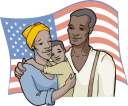
Worksheets and No Prep Teaching Resources
Reading Comprehension Worksheets
Black History and Blacks in U.S. History

Black History and Blacks in U.S. History
 Worksheets and No Prep Teaching Resources Reading Comprehension Worksheets Black History and Blacks in U.S. History |
 Black History and Blacks in U.S. History |
| edHelper's suggested reading level: | grades 7 to 8 | |
| Flesch-Kincaid grade level: | 8.74 |
|
The Slave Trade
By Brenda B. Covert |

|
 |
Create Weekly Reading Books
Prepare for an entire week at once! |
| Leave your feedback on The Slave Trade (use this link if you found an error in the story) |
 |
Black History and Blacks in U.S. History
|
 |
United States
|
|
|
 | Fifty States Theme Unit |
 |
Document Based Activities |